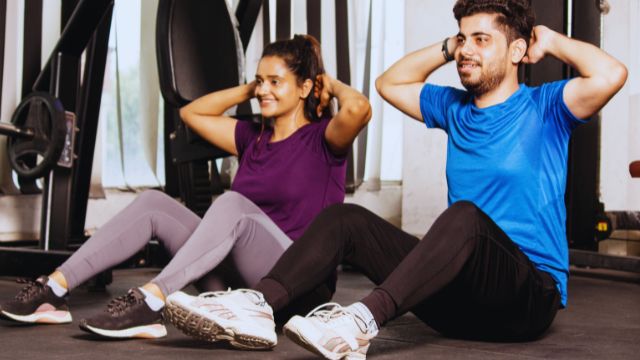Staying fit doesn’t require a gym membership or fancy equipment. In 2025, with a growing emphasis on accessible and sustainable health practices, people are discovering creative ways to maintain physical fitness from the comfort of their homes or nearby surroundings. Whether you’re pressed for time, prefer to avoid crowded gyms, or simply want to embrace a more natural approach to exercise, there are countless ways to stay active and healthy. This article explores ten effective and enjoyable methods to stay fit without stepping foot in a gym. From leveraging your environment to incorporating movement into daily life, these strategies will help you achieve your fitness goals with ease and flexibility.
1. Embrace Outdoor Walking for Cardiovascular Health
Walking is one of the simplest yet most powerful ways to stay fit. In 2025, with urban parks and nature trails more accessible than ever, lacing up your shoes and heading outside offers both physical and mental benefits. A brisk 30-minute walk five days a week can improve cardiovascular health, boost mood, and burn calories. Explore your neighborhood, find a scenic trail, or walk along a beach to keep things interesting. To increase intensity, try interval walking—alternating between fast and moderate paces—or add a hilly route. The beauty of walking lies in its accessibility, requiring no equipment beyond comfortable shoes and a willingness to move.
2. Incorporate Bodyweight Exercises into Your Routine
Bodyweight exercises are a versatile and effective way to build strength and endurance without a gym. Movements like push-ups, squats, lunges, and planks engage multiple muscle groups and can be done anywhere. In 2025, online platforms and apps make it easy to follow guided bodyweight workouts tailored to your fitness level. Set aside 20 minutes a day in your living room or backyard for a circuit that combines strength and cardio. The key is consistency and progression—gradually increasing reps or trying advanced variations like one-legged squats. This approach keeps your muscles challenged and your workouts equipment-free.
3. Dance Your Way to Fitness
Dancing is a joyful way to stay fit while having fun. Whether it’s salsa, hip-hop, or freestyle, dancing elevates your heart rate, improves coordination, and strengthens muscles. In 2025, virtual dance classes and tutorials are widely available, allowing you to learn new moves from home. Alternatively, put on your favorite playlist and move freely in your living room. Even 15 minutes of high-energy dancing can burn significant calories and release endorphins. The social aspect of joining a local dance group or inviting friends for a dance session adds motivation, making fitness feel less like a chore and more like a celebration.
4. Use Household Items for Strength Training
You don’t need dumbbells to build muscle—everyday household items can double as workout tools. In 2025, creative fitness enthusiasts are turning water jugs, backpacks filled with books, or even sturdy chairs into strength-training equipment. For example, lift a gallon of water for bicep curls, use a chair for tricep dips, or carry a heavy backpack for weighted squats. These improvised tools add resistance to your workouts, helping you tone muscles without a gym. Experiment with different items and adjust the weight to suit your strength level, ensuring a safe and effective session wherever you are.
5. Practice Yoga for Flexibility and Strength
Yoga is a holistic fitness practice that enhances flexibility, strength, and mental well-being. In 2025, with countless online yoga classes available, you can roll out a mat in your home or a park and follow along with instructors of all styles. Poses like downward dog, warrior, and tree pose build muscle endurance while improving balance and reducing stress. Even a 15-minute daily flow can make a difference, especially if you focus on breathwork to stay present. Yoga’s adaptability means you can tailor sessions to your mood—gentle stretches for relaxation or power yoga for a challenge—making it a gym-free fitness staple.
6. Take Up Cycling for Fun and Fitness
Cycling is an excellent low-impact way to stay fit, whether you’re riding a bike around your neighborhood or using a stationary bike at home. In 2025, bike-sharing programs and affordable home cycling apps make this activity more accessible. A 30-minute ride at a moderate pace strengthens your legs, boosts cardiovascular health, and burns calories. Explore local paths, commute to nearby errands, or join a community cycling group to stay motivated. If outdoor cycling isn’t an option, a simple bike stand can turn any bicycle into a stationary one, letting you pedal while watching a show or listening to music.
7. Engage in Active Hobbies for Natural Movement
Turning hobbies into fitness opportunities is a seamless way to stay active. In 2025, people are embracing activities like gardening, hiking, or even cleaning as ways to move their bodies. Digging in a garden builds upper-body strength, while hiking a local trail combines cardio and nature’s calming effects. Even vigorous house cleaning—think scrubbing floors or rearranging furniture—counts as exercise. The key is to approach these tasks with intention, moving dynamically to elevate your heart rate. By integrating physical activity into hobbies you enjoy, fitness becomes a natural part of your lifestyle rather than a separate obligation.
8. Try High-Intensity Interval Training at Home
High-intensity interval training (HIIT) is a time-efficient way to stay fit without a gym. In 2025, HIIT’s popularity continues due to its effectiveness and flexibility. A typical session involves short bursts of intense exercises—like jumping jacks or burpees—followed by brief rest periods, all done in 15 to 20 minutes. You can perform HIIT in your living room, backyard, or a park, using only your body weight. Online videos and apps offer guided routines, but you can also create your own by combining moves you enjoy. HIIT boosts metabolism, improves endurance, and requires no equipment, making it perfect for busy schedules.
9. Swim for a Full-Body Workout
Swimming is a fantastic gym-free exercise that works nearly every muscle group while being gentle on joints. In 2025, community pools, lakes, and beaches provide ample opportunities to dive in. A 30-minute swim session, whether doing laps or treading water, improves cardiovascular fitness and builds strength. If you’re near a natural body of water, open-water swimming adds an element of adventure. For those without regular access, even occasional swims during vacations or visits to local facilities can contribute to fitness. The rhythmic nature of swimming also promotes relaxation, offering a mental boost alongside physical benefits.
10. Prioritize Active Recovery and Stretching
Staying fit isn’t just about intense workouts—active recovery and stretching are equally important. In 2025, with a focus on holistic health, practices like dynamic stretching or gentle movement sessions are gaining traction. Spend 10 minutes each morning doing stretches that target major muscle groups, such as hamstrings and shoulders, to improve mobility and prevent injury. Activities like tai chi or a leisurely walk on rest days keep you moving without overexertion. Incorporating recovery into your routine ensures your body stays balanced and ready for more active days, all without needing a gym.
11. The Importance of Consistency in Gym-Free Fitness
The success of these gym-free methods hinges on consistency. In 2025, with distractions like work and technology ever-present, carving out time for movement requires intention. Start small, perhaps with a daily walk or a short yoga flow, and gradually build a routine that fits your lifestyle. Tracking progress through a journal or fitness app can keep you motivated, as can involving friends or family for accountability. Even on busy days, a quick 10-minute HIIT session or a stretch break counts. Over time, these small efforts compound, leading to improved strength, stamina, and overall health.
12. Overcoming Barriers to Staying Active
Staying fit without a gym isn’t without challenges. Limited space, lack of motivation, or unpredictable schedules can make it hard to stick with a routine. In 2025, overcoming these barriers starts with flexibility—choose activities that suit your environment, like bodyweight exercises in a small apartment. To combat low motivation, mix up your routine with dancing or cycling to keep things fresh. If time is tight, integrate movement into daily tasks, like walking during phone calls. Viewing fitness as a form of self-care rather than a chore helps you stay committed, even when obstacles arise.
13. The Mental and Physical Benefits of Gym-Free Fitness
Beyond physical health, these gym-free methods enhance mental well-being. In 2025, research continues to show that regular movement reduces stress, improves sleep, and boosts confidence. Activities like yoga and dancing foster mindfulness, while outdoor walking and cycling connect you with nature. The accessibility of these methods means anyone can participate, regardless of budget or location. By prioritizing fitness in a way that feels enjoyable and sustainable, you create a positive feedback loop—feeling better physically fuels your motivation to keep moving, which in turn uplifts your mood and energy.
14. Building a Personalized Fitness Routine
The beauty of gym-free fitness lies in its adaptability. In 2025, personalization is key to making exercise a lasting habit. Combine activities you enjoy—perhaps morning yoga, evening walks, and weekend swims—into a weekly plan that suits your schedule. Experiment with different methods to find what energizes you most, and don’t be afraid to adjust as life changes. Listening to your body and celebrating small milestones, like walking an extra mile or mastering a new dance move, keeps the journey rewarding. A tailored routine ensures fitness feels like a natural, fulfilling part of your life.
15.Conclusion: Start Your Gym-Free Fitness Journey Today
Staying fit without a gym is not only possible but also incredibly rewarding. The ten methods outlined—walking, bodyweight exercises, dancing, household strength training, yoga, cycling, active hobbies, HIIT, swimming, and active recovery—offer diverse, accessible ways to prioritize health in 2025. Each requires minimal equipment and can be adapted to your environment, making fitness inclusive and sustainable. Begin with one or two strategies that excite you, and build from there. By embracing movement in ways that spark joy, you’ll not only stay fit but also cultivate a healthier, happier version of yourself.

